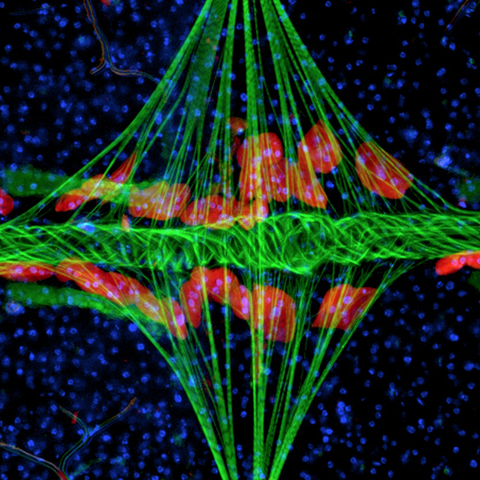 |
This is a file from the Wikimedia Commons. Information from its description page there is shown below.
Commons is a freely licensed media file repository. You can help.
|
Summary
| Description |
English: This fluorescence image details the structural organization of the heart of the mosquito Anopheles gambiae. The point of view is top down, with the mosquito's body lying horizontally with its head to the left (outside of the image). Muscle is labeled with phalloidin (green), and shows the tube-like heart extending horizontally across the body and the diamond shaped alary muscles projecting vertically onto the heart. The pericardial cells, labeled with 568 nm-Immunoglobulin G (red), are pinocytic cells that flank the heart. Cell nuclei are labeled with Hoechst 33342 (blue).Image Credit: Jonas G. King and Julián F. Hillyer, Department of Biological Sciences, Vanderbilt University. Issue image, PLOS Pathogens, November 2012.
|
| Date |
2 December 2012, 02:55:26 |
| Source |
King JG, Hillyer JF (2012) Infection-Induced Interaction between the Mosquito Circulatory and Immune Systems. PLoS Pathog 8(11): e1003058. doi:10.1371/journal.ppat.1003058 |
| Author |
King JG, Hillyer JF |
Licensing

 |
This file is licensed under the Creative Commons Attribution 2.5 Generic license. |
|
|
|
- You are free:
- to share – to copy, distribute and transmit the work
- to remix – to adapt the work
- Under the following conditions:
- attribution – You must attribute the work in the manner specified by the author or licensor (but not in any way that suggests that they endorse you or your use of the work).
http://creativecommons.org/licenses/by/2.5 CC-BY-2.5 Creative Commons Attribution 2.5 truetrue
|
File usage
The following pages on Schools Wikipedia link to this image (list may be incomplete):
This file contains additional information, probably added from the digital camera or scanner used to create or digitize it. If the file has been modified from its original state, some details may not fully reflect the modified file.
Wikipedia for Schools was collected by SOS Children's Villages. SOS Childrens Villages helps those who have nothing and no one, giving them back the famly they have lost and bringing them the very best opportunities for a happy, healthy future. There are many ways to help with SOS Children.


